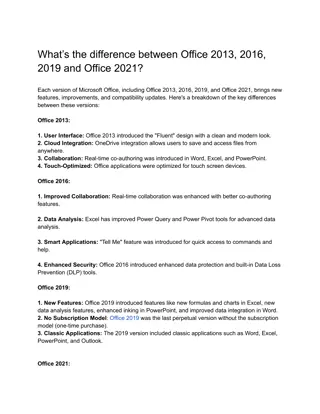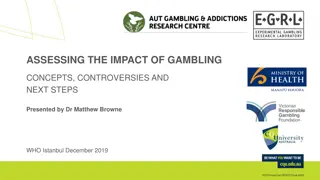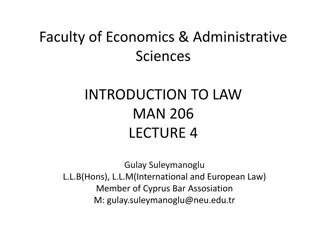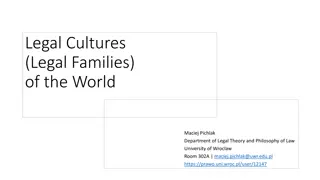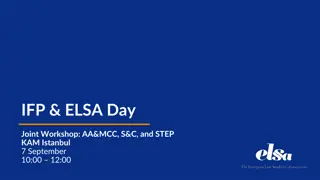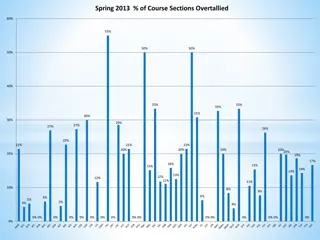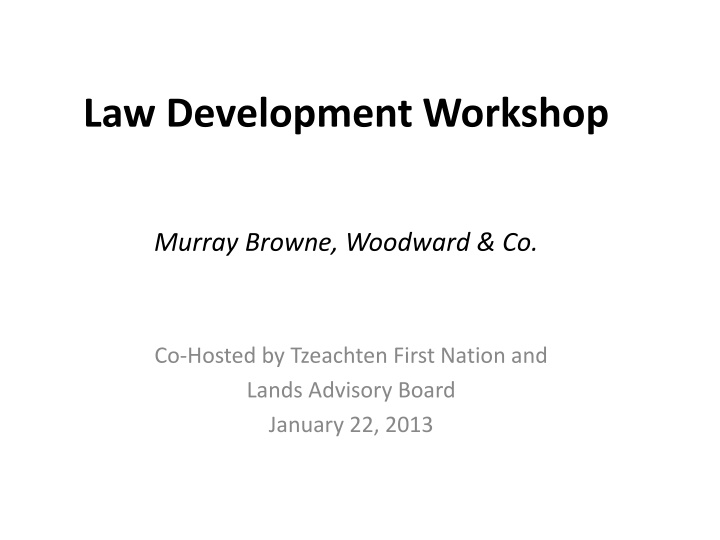
Law Development Workshop for First Nations: Importance and Process
Explore the significance of law development workshops for First Nations, focusing on the role of laws, regulations, policies, and strategic objectives in land code implementation. Learn about the key steps involved in lawmaking and the tools used to achieve strategic goals effectively.
Download Presentation

Please find below an Image/Link to download the presentation.
The content on the website is provided AS IS for your information and personal use only. It may not be sold, licensed, or shared on other websites without obtaining consent from the author. If you encounter any issues during the download, it is possible that the publisher has removed the file from their server.
You are allowed to download the files provided on this website for personal or commercial use, subject to the condition that they are used lawfully. All files are the property of their respective owners.
The content on the website is provided AS IS for your information and personal use only. It may not be sold, licensed, or shared on other websites without obtaining consent from the author.
E N D
Presentation Transcript
Law Development Workshop Murray Browne, Woodward & Co. Co-Hosted by Tzeachten First Nation and Lands Advisory Board January 22, 2013
Draft Agenda 9:00 am Opening Prayer 9:10 am Welcome (Tzeachten First Nation) 9:15 am Introductions 9:20 am Opening Comments - Why are we having this workshop? (Val Sam) 9:30 am Law Making (Murray Browne, Woodward & Co.) - What are Laws, Regulations and Policies and When to Use Them - Group Exercise: Take Your Pick (Law, Reg or Policy?) 10:40 am HEALTH BREAK 10:50 am How to assess relevant laws and priorities for your First Nation - What is the Bad your Nation is trying to prevent or the Good it is trying to promote? - Basic Core Laws Law-Making - Some Do s and Don t s LUNCH Law-Making - Enforcement Issues - Discussion 11:30 am 12:00 noon 12:30 pm 2
WHY WE ARE HERE? THE ROLE OF LAW DEVELOPMENT IN LAND CODE IMPLEMENTATION (Valerie Sam) 4
LAWMAKING CHOOSINGTHE RIGHT TOOLS: Laws, Regulations, and Administrative Policies/ Procedures (Murray Browne, Woodward & Co.) 5
Council Strategic Direction Broad, general principles to set the vision and priorities for your First Nation. Ideally, laws and policies should be developed based on principles, visions and priorities, rather than reactions to immediate issues.
Tools to achieve strategic objectives: Creating programs, Making agreements, Providing funding, services, Education, Creating incentives and disincentives, Creating laws and regulations, Creating policies and procedures 7
Laws A Rule of conduct approved and enforced by the government commanding what is right and prohibiting what is wrong Are legally binding May create penalties and offences Authorize enforcement measures 8
Laws Are passed under an original source of jurisdiction (e.g. Canadian Constitution or FNLMA) vs. bylaws which are delegated. Before a draft bill or law can become a law, it must go through a series of steps that allow it to be debated and amended. In order to become law, a bill must receive a majority of votes in parliament or the provincial legislature. 9
For Land Code laws It is important to confirm that there is authority under the Land Code for the type of law. Follow the requirements for consultation with community and committee or approval by the community or Council. Try to follow the traditions, teachings and culture of your First Nation. 10
When is a Law the best tool? When required by your Land Code. When there are issues of fundamental importance. When there are sufficient resources for implementation and enforcement. When mandatory standards or prohibitions need to be set. When enforcement tools are required. 11
When is a Law NOT the best tool? When there is a lot of detail that needs to be regularly revised (laws take time to amend; usually changeable details go into regulations or policies) If there are not sufficient resources to implement and enforce it. When the goal is educational or aspirational. 12
Regulations Contain the details to make a Law work. (Ex: if a Law requires a meeting to be held, the regulations would set out how many days in advance, the form of the notice, etc.) Can be amended more easily than Laws. Are usually created under delegated authority. Council may delegate regulation-making powers through the parent law. Are still legally binding (compared to policies which are not). 13
Regulations are the best tool when A decision is not of fundamental importance. A non-controversial aspect of the law may need to be altered easily or often. There are details that clarify issues in the related Act. It is clear who has the authority to make and amend the regulations. 14
Regulations should NOT: Limit personal rights or freedoms. Deal with matters of fundamental importance These should be in the law itself. Allow for the transfer or sub-delegation of the power to make regulations to other parties. Exceed the limits set out in the Law that created them. Include vision statements or educational goals. Include items that are not enforceable. 15
Policies and Guidelines Help maintain consistency in decision-making. May support laws, or implement a non- legislative government objective. Are NOT legally binding. Give direction to program managers and staff about how to make decisions (eg: how to decide when a fee should be waived, etc.) Provide guidance to applicants about application procedures(eg: what forms to use, how long processing takes). 16
When are Policies the best tool? When there does not need to be the force of law (when the goal is to educate, promote, or implement rather than to enforce). When there are repeated applications or decisions and a policy is needed to ensure consistency. When there are minor gaps in the implementation of laws or regulations. When a decision must be made about how to spend pre-determined funding or manage programs. To simplify or explain a law to people using it (such as members or applicants). 17
GROUP EXERCISE: Take your pick Would you use a law, regulation or policy or a combination for the following? a) b) c) d) e) f) g) Banning fireworks except with a permit. _________________________________________________________ Requiring dogs to be licensed. _________________________________________________________ Encouraging pet owners to spay or neuter their pets. _________________________________________________________ Dealing with dumping of garbage and junk. _________________________________________________________ Setting out the requirements for business license applications. _________________________________________________________ Dealing with contamination under a buckshee lease. _________________________________________________________ Setting out development and Building Code standards. __________________________________________________________ 18
How to assess relevant laws and priorities for your First Nation Do you have a vision, strategic direction, priority statement or workplan from Council? What is the Bad your Nation is trying to prevent or the Good it is trying to promote? 19
How to assess relevant laws and priorities for your First Nation Does your First Nation have basic core land laws in place? Check other First Nations and governments for relevant laws: Zoning and land use. Subdivision, development and servicing laws. Granting interests in land. Environmental protections. Good neighbour (anti-nuisance, anti-noise, unsightly premises, etc.) 20
LAWMAKING BASICS Do s and Don ts 21
Legislative Drafting Dos Do: a) Follow your Land Code and the Framework Agreement. b) Follow your Nation s traditions and teachings. c) Where appropriate or required, seek community input on key issues and values to inform the law. d) Find ways to engage with members that are informal and comfortable. e) Consider which draft provisions need to be in the law and which belong in regulations or policies f) Think about enforcement: what tools are available and how can the law be effectively and inexpensively enforced? g) Test drive the law with hypothetical scenarios and examples to see if it will work. 22
Legislative Drafting Dos (contd) h) Use preambles to provide context and goals for the law i) Use plain English and keep it simple j) Use consistent terminology and terms k) Define key terms, but do not define terms that are used only once l) Use cross-references sparingly m) Work with the staff who will be implementing the law to develop schedules, regulations, policies, application forms, permits, etc. n) Proofread the draft law many times 23
Legislative Drafting Donts DON T: a) Only communicate when you need something from members (eg: a ratification vote) b) Ignore members or stakeholders legitimate concerns c) Make assumptions: if you don't know, ask d) Blindly cut and paste or use wording from precedents that may not apply to your Nation e) Include provisions that do not conform with your Land Code 24
Legislative Drafting Donts (cont.) f) Draft wording that is difficult to understand, is overly complex or legalistic g) Include provisions that you don t understand or can t easily explain to others h) Use inconsistent or ambiguous wording i) Draft large complex structures or bureaucracies or processes that will be difficult and expensive to implement j) Draft laws or provisions that are impossible or very difficult or expensive to enforce 25
ENFORCEMENT Who will be enforcing the law? (Lands manager, Band manager, Enforcement officer, Bailiff, RCMP, JP) What tools can be built in to the law and policy? (Education, Warnings, Stop-work orders, remediation orders, tickets, fines) Can you coordinate with other entities? (Other First Nations, municipalities and regional districts, SPCA, RCMP, etc.) 26
Discussion and Questions? Thank You 27

